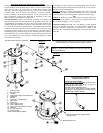
4
PRESSURE BUILD-UP (THERMAL EXPANSION)
During the heating cycle of the water heater, the water expands creating
a
pressure build-up in the plumbing system. If the pressure exceeds 150 PSI,
water will come out of the valve. This is a normal safety function of the
T&P valve. The water supply meter may have a check valve or back flow
preventer inside. This can increase the possibility of pressure build-up.
Causes of discharge can be thermal expansion, excess system pressure, too
high a temperature setting on the thermostat or something in the water
heater causing excess temperatures in the heater.
Thermal Expansion: When water is heated it expands. For example, in
a
40-gallon water heater, water being heated to its thermostat setting will end
up expanding by approximately 1/2 gallon. This extra volume created by the
expansion has to go somewhere or pressure will dramatically increase, such
as when water is heated in a closed system. A good indication of thermal
expansion is when the T&P valve releases about one cup of water for every
10 gallons of heater capacity with each heating cycle. The T&P valve is
functioning properly when it relieves pressure caused by thermal expansion,
but frequent relief can result in a build up of natural mineral deposits on the
valve seat, rendering the valve inoperative. Should this happen, the T&P
valve needs to be replaced.
Alternate location of
p
ressure relief valve
Location of pressure relief and \ or expansion tank if a check valve or
pressure reducing valve is in the cold water supply to the house.
1. Cold water inlet
2. Hot water outlet
3. Anode(s)
4. Temperature and pressure relief valve*
5. Thermostat
6. Element
7. Access door – not illustrated
8. Floor drain
9. Drain valve
10. Water supply to meter
11. Water supply to home
12. Water meter with backflow preventer
13. Overflow
14. Pressure relief valve
15. Expansion tank
*Items to be supplied by installer
Use option 1 or 2 as convenient. If a pressure relief valve is used
(OPTION 1) select one with a setting 25 psi below the relief valve
ratin
g
used on the heater.
OPTION 2
OPTION 1
SPACESAVER™ MODELS
(SIDE OUTLET) ONLY
NOTE TO INSTALLERS:
A bent tube (as shown) is installed for the hot water
outlet on side outlet water heaters to ensure a
maximum of hot water supply.
This fitting must be aligned properly.
The ‘line’ on the fitting must be oriented pointing
up. When in correct position, the hot water is drawn
from the highest point in the tank.
Refer to pressure relief \ expansion tank
schematic above.
Tee fitting and drain valve
To prevent this ‘T & P VALVE’ from discharging hot water, the loss o
f
energy and reduce the possible build-up of lime in the ‘T & P VALVE’
there are two (2) recommendations:
OPTION 1: Install a 125 PSI Pressure Relief (only) valve in the cold
water supply line. Make sure that the discharge of this valve is directed
to a drain to prevent water damage and it is protected from freezing,
OR
OPTION 2: Install an expansion tank on the cold water supply line.
For every 50 U.S. gallons of stored water, the expansion tank must
have a minimum capacity of 1.5 U.S. gallons.
Temperature Relief: The T&P valve will discharge varying amounts
of water, but typically more than you would experience from thermal
expansion. Check the temperature in relation to the setting on the
thermostat dial. A malfunctioning thermostat could cause the water to
get too hot.








